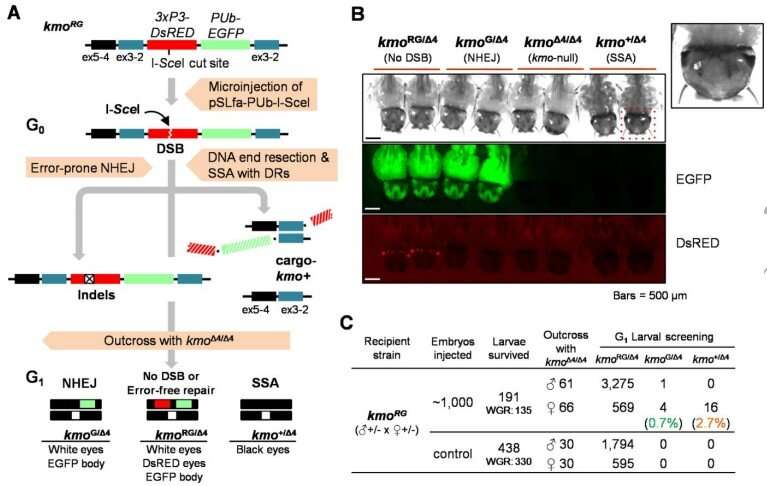Self-eliminating genes tested on mosquitoes

Texas A&M AgriLife Research scientists have tested a technology to make temporary genetic modifications in mosquitoes. The modifications self-delete over time.
The mechanism to make temporary genetic changes could be important for scientists hoping to modify mosquitoes in ways that help manage populations and prevent vector-borne diseases like West Nile virus without permanently altering wild populations' genetic makeup.
An article detailing their test results, "Engineering a self-eliminating transgene in the yellow fever mosquito, Aedes aegypti," was published in PNAS Nexus. The authors, Zach Adelman, Ph.D., and Kevin Myles, Ph.D., both professors in the Texas A&M College of Agriculture and Life Sciences Department of Entomology, describe a method for programming the removal of edited genes within populations of mosquitoes over multiple generations.
The method is a first step toward building safeguards for genetic modifications developed to control populations of mosquitoes and the vector-borne diseases they carry. The idea is to test proposed changes without making the changes permanent and without the risk of transmitting them to wild populations, Adelman said.
"There are lots of ecological questions we don't know the answers to, and when you are testing technology, you don't want to get into a situation where you have to tell a regulatory agency or the public that 'if something bad happens, we're just out of luck,'" Adelman said. "This mechanism is about how we get back to normal whether the experiment does or doesn't come out the way we expect."
Adelman and Myles are co-directing a team of scientists who received a five-year, $3.9 million grant from the National Institute of Allergy and Infectious Diseases to test and fine-tune the self-eliminating transgene technology.
Back to normal in a few generations
To prevent mosquito-transmitted diseases, approaches based on genetic control of insect populations are being developed, Adelman said. However, many of these strategies are based on highly invasive, self-propagating transgenes that can rapidly spread the trait into other populations of mosquitoes.
Keun Chae, Ph.D., a post-doctoral researcher in Adelman's group, led the experiments in Aedes aegypti mosquitoes, which are known vectors of diseases. Taking advantage of a form of DNA repair, Chae engineered a duplicated genetic code region along with two genes for fluorescent proteins into the middle of a gene important for eye pigment.
The result was a white-eyed mosquito, and also red and green fluorescence in the eyes and body. When combined with a site-specific nuclease, which is essential for many aspects of DNA repair, they acted as a precise set of molecular scissors that could cut the transgene sequences. Over several generations, mosquitoes regained their normal eye pigment and lost the modified genes.
Adelman said the work is proof of principle that scientists can do two important things—remove transgenes placed in mosquitoes and repair disrupted genes.
"Many groups are developing genetic methods for mosquito population control," Adelman said. "Our method provides a braking system that can restore sequences in the wild."
Self-editing transgenes could be leap for genetic research
Myles said creating this self-editing transgene is the first step in a longer process. The mosquito genome is not easy to manipulate, and the breakthrough is the culmination of around six years of experimental work.
But this first publication starts to address concerns about genetic modification in wild populations, he said. As genetic modification technology advances, Adelman and Myles believe this mechanism will allow researchers to evaluate the effects of changes more safely within the environment and on animals other than mosquitoes.
"These are highly conserved genetic pathways, and there is every reason to believe this method could be applied to a diverse range of organisms," Myles said.
Both scientists are looking forward to expanding the application of their discovery in the context of highly active gene drive. They hope their method will be useful for geneticists and in pushing the boundaries of genetic research.
More information: Keun Chae et al, Engineering a self-eliminating transgene in the yellow fever mosquito, Aedes aegypti, PNAS Nexus (2022). DOI: 10.1093/pnasnexus/pgac037
Provided by Texas A&M University



















